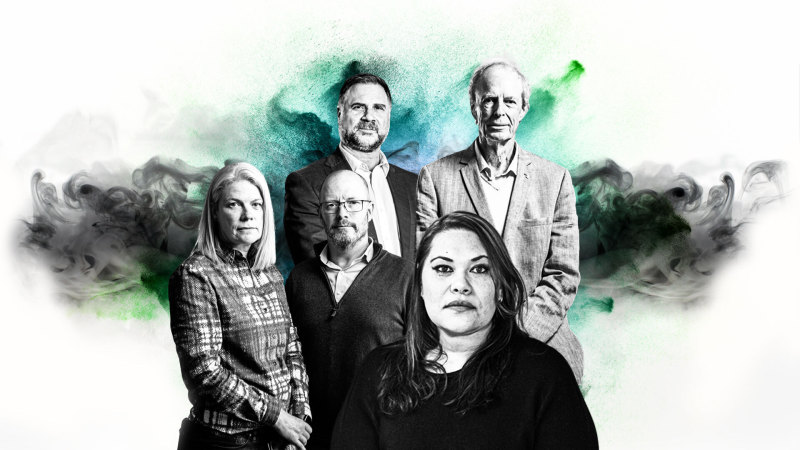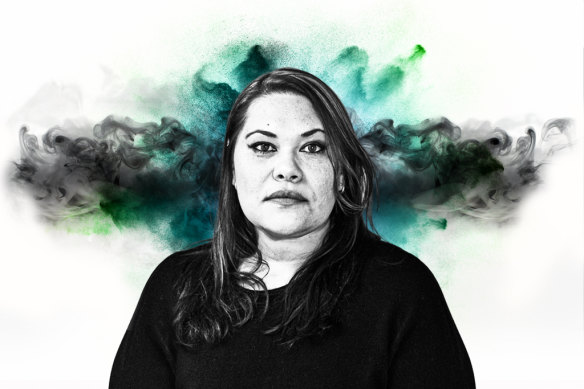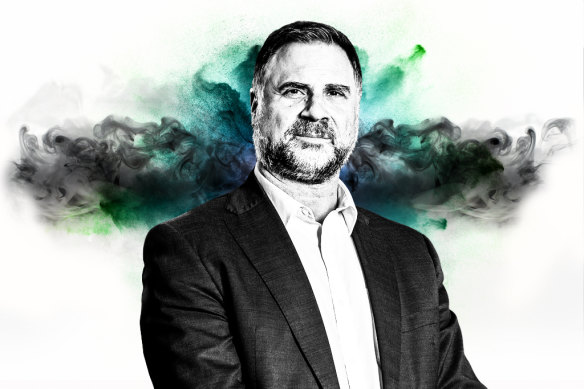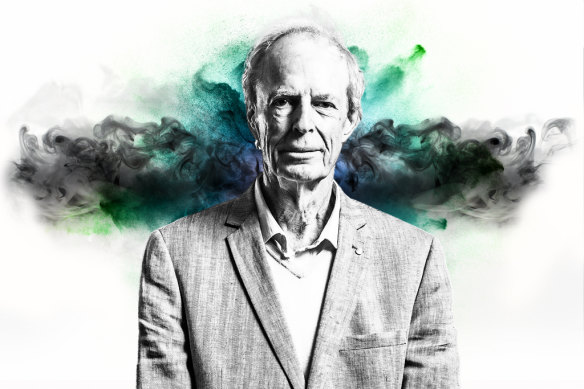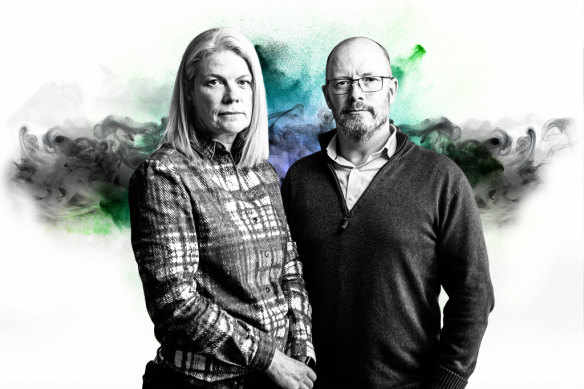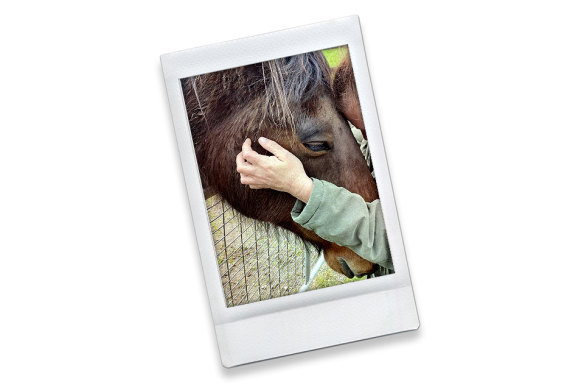Faced with a life-threatening event, we fight, flee or freeze. But the horror can remain, splitting life into ‘before and after’. Why? And what can help?
Save articles for later
Add articles to your saved list and come back to them any time.
Rebeca Carro was in her local supermarket when she heard the boom. The sound speared her through. “I broke out in a cold sweat,” she recalls. “And suddenly, I couldn’t remember where I lived – or who I was.”
The boom turned out to be a car backfiring. Startling to any of us, sure, but Carro’s ex-partner had kept guns. After surviving a decade of abuse at his hands, including being strangled, stalked, pushed downstairs and beaten so badly while seven months pregnant that she miscarried, Carro had finally escaped him, renting a little unit tucked out of sight above some shops. Now, in an instant, it had all come crashing back: the terror of those years with him, moments when she was sure he was going to kill her.
The boom was the trigger. The chemicals flooding her body, sending her heart racing and shrinking her vision, was the same fight-or-flight kick that had helped her survive the attacks. But this time it had left her shaking and unable to speak in the middle of her local IGA. “I had to call the police for help,” Carro says. “I didn’t know how to get home. That’s when I was diagnosed with PTSD. I’d thought that was only for soldiers.”
More than a million Australians are living with PTSD, or post-traumatic stress disorder. It’s the second-most common mental health condition after depression. Some have carried it home from battlefields. For others, their homes are the battlefield, says Carro, who now works in domestic violence support.
Trauma can come in many forms and from many shocks. Crimes. Accidents. Natural disasters. It leaves traces, not just in our memories but in our bodies, in our muscles and neural circuitry, even in our immune systems, as psychiatrist Bessel Van der Kolk writes in his seminal book The Body Keeps the Score. Yet trauma and its after-effects can be healed too and today more treatments, from art therapy to psychedelics, are getting attention.
What is trauma? Why do some of us develop PTSD after a trauma and others don’t? And what can help?
Rebeca Carro: “I’d thought [PTSD] was only for soldiers.”Credit: Photo: Joe Armao. Artwork: Marija Ercegovac
What is trauma?
At some point, most of us – more than 70 per cent of Australians – will be rocked by a traumatic event, one that overwhelms us, either temporarily or longer-term. Psychologist Professor David Forbes first saw trauma in his patients while working for a bank in the late ’80s. “Those were still the days of bank hold-ups, and I’d treat the survivors on staff,” says Forbes, who heads national trauma research centre Phoenix Australia. “Back then we were only just starting to talk about trauma.”
These days we might routinely self-diagnose it. But there are things that make trauma distinct from other awful things that happen to us, Forbes says. Usually, it involves a threat or a violation. Fearing you might be shot dead while caught in a bank robbery, say, is different to the distress of being fired from that bank.
At other times, it’s horror. seeing someone killed in a car crash right before your eyes as opposed to hearing of a fatal collision on the news. In fact, being exposed to ongoing horror, even safe behind a screen in an office, can be traumatising. Think of police sifting through hours of child abuse footage online or emergency call-centre operators hearing tragedies unfolding day in, day out.
‘It has pierced you. When it rears its head, it’s like an open wound.’
Trauma means wound in Greek. “And that’s exactly it,” says advocate Julianne, who has survived childhood sexual abuse and then years of domestic violence and does not want her last name published due to safety concerns. “It has pierced you. When it rears its head, it’s like an open wound.”
Not being able to do anything when tragedy strikes can be particularly damaging, says psychologist Michael Burge, who developed trauma response teams for Vietnam War veterans in regional Australia in the ’80s and ’90s. That’s why experts consider even hearing of a sudden, shocking death of someone close to you to be a kind of trauma. You can’t save your loved one, or say goodbye.
Collective trauma can rock whole communities when members are targeted. “I’ve treated patients from war-torn countries where secret police were coming to take people away and any knock at the door was a worry,” says Burge.
“Trauma at its core is disempowering,” adds Forbes. Your world has been turned upside down in a moment, cleaved in two, into before and after.
People respond differently. Some stay hyped up, trapped in the surge of adrenaline that arrives when our fight or flight mode is tripped by a threat. Others freeze or shut down, a phenomenon called disassociation. “A lot of veterans would describe feeling as though they were floating above themselves while fighting in the jungle, above the trees looking down,” says Burge.
‘You’ll meet five-year-olds as traumatised as war veterans who’ve seen people blown up in front of them.’
Ongoing abuse and violation, of the kind Carro and Julianne endured, might lower a person’s guard against future mistreatment, trapping them in more abusive relationships even as they become extra alert to danger. This kind of reaction to long-term trauma is now known as complex PTSD. In children, such trauma, including from family violence, can rewire the brain. “You’ll meet five-year-olds as traumatised as war veterans who’ve seen people blown up in front of them,” Burge says.
But not everyone exposed to trauma gets PTSD. Between 5 and 10 per cent of Australians will develop the condition, but among the military that rate is far higher, about 20 per cent; and in sexual assault survivors it’s more than half.)
David Forbes: “Trauma at its core is disempowering,”Credit: Photo: Darrian Traynor. Artwork: Marija Ercegovac
How does trauma affect us – and what’s PTSD?
In 1980, veterans’ shellshock, once thought to be actual brain damage from explosions and gunfire, was finally recognised as a psychological condition: PTSD. Today, though, experts understand it really does affect the whole body, from the brain and its neurons to the gut.
The human brain evolved when we were still routinely hunted by sabertooth tigers – its job is to keep us alive. When it senses a threat, the brain reverts to its most ancient programming. As stress hormones flood the body, giving it a surge of energy to run or fight, other parts of the brain shut down. “It’s not the time for high-order thinking,” says Forbes. The body already knows what to do. Your vision will shrink and focus. Your heart rate and oxygen intake will climb. You might be fleeing or fighting (or sometimes freezing) before you even realise what’s happening.
‘This heightened state usually settles over the course of a few days or weeks. At other times, that fear response gets stuck.’
Most of us will start to regain our senses and think clearly again once the threat has passed, though the shock can linger. Many Ukrainians who fled Russian bombs and soldiers, for example, have described being unable to speak for days after reaching safety. “But this heightened state usually settles over the course of a few days or weeks,” says Forbes. “At other times, that fear response gets stuck.”
People who are stuck – those with PTSD – are haunted by flashbacks and nightmares of the traumatic event. They seem to experience it over and over and will often withdraw to avoid triggers and reminders. They may become numb, trapped in what Burge calls a kind of emotional paralysis, unable to enjoy their lives. At the same time, they are hyper-vigilant, their minds constantly hunting for danger.
Panic attacks, sleep problems, irritability, suicidal ideation and rages are all common. Over time, PTSD can lead to more widespread health problems (beyond the effects of common “coping” strategies such as drugs or alcohol). There are cases of stomach disease and high blood pressure – both parts of the body linked to our nervous system – but also, Burge says, cancer and heart problems. “Stress really does eat into the body.”
Carro and Julianne each recall periods of crippling agoraphobia that trapped them indoors for the first months of their PTSD. “Even today I can get overwhelmed just at the supermarket,” says Julianne. An NDIS support worker now helps her get around.
Medication can temporarily reduce some of these symptoms, such as sleeping pills to help someone rest or anti-anxiety drugs to dampen hyperarousal. (Carro was prescribed Xanax to manage her panic attacks for more than a year before becoming addicted and weaning herself off.)
‘The traumatic shock was locked in. Until he could resolve that, he couldn’t stop the nightmares.’
But experts say PTSD itself can be treated only by helping the person process the trauma “stuck” in their mind. Burge recalls treating a soldier who had been pinned down alone in battle, facing certain death, when his own troops burst through at the last minute to save him. “Only, in his dreams he’d never get to the part where he was rescued, just when he was about to die. The traumatic shock was locked in. Until he could resolve that, he couldn’t stop the nightmares.”
Michael Burge: “No matter how dark the clouds are, there’s always hope.”Credit: Photo: Chris Hopkins. Artwork: Marija Ercegovac
Why do people with PTSD get flashbacks?
Before PTSD was understood, doctors caring for traumatised veterans wondered if they might have developed schizophrenia, so strong were their flashbacks. It seemed as if anything could set them off. They might be sitting in an innocuous office, and the whirring of a ceiling fan would become a roaring helicopter blade from an incoming enemy attack.
“I thought I was crazy,” says Carro of her own vivid flashbacks, “because my ex had always said I was and now he was gone but I was still experiencing these things.”
When the brains of people with PTSD are scanned during flashbacks, the fear and emotional centres of the brain are lit up. “After trauma, the world is experienced with a different nervous system,” writes Van der Kolk. The body’s alarm system has been recalibrated – with new triggers.
The sound of a bottle set down on a table still sends a jolt through Carro. (“My ex was a big drinker. I avoid pubs now.“) For Julianne, it’s the smell of men’s aftershave.
In fight or flight mode, our mind makes memories a little differently. The part of the brain that sorts experiences into a meaningful story, an autobiography, switches off. At the same time, other parts are rushing to encode as much sensory detail as possible. “Because nature wants to remember this threat,” says Forbes. “And the things that jump out are the most dangerous parts – the glint of a knife in the dark.”
Traumatic memories can stay so sharp that they start to throw everyday life into shadow. People lose their passion, they feel numb.
It is the more primitive (and less discerning) parts of our brain that continue to stay alert after a trauma, scanning for any sign, however small, of that same threat. That’s why even passingly familiar sounds, smells and events can trip our newly heightened danger sense. And it’s why traumatic memories tend to be fragmented, rich sensory flashes rather than a clear story. They can stay so sharp that they start to throw everyday life into shadow. People lose their passion, they feel numb.
Therapy involves stitching back together the story of what happened. “Otherwise it’s like opening a PDF,” says Forbes.” You can’t change anything. You can’t think about it differently. It’s happening now in living colour. So, it hits you over and over.”
A safe therapy environment, he says, is like “keeping that memory open in a Word document, so you can work on it.”
One of the key therapies recommended is cognitive behavioural therapy (CBT), which aims to slowly desensitise the person to the traumatic memory so they can properly process it. “And you can understand maybe why you couldn’t have done anything more or why you didn’t fight back,” says Forbes. Often people are racked by deep shame or guilt. They may have had just a split second, facing two bad options, “but get fixated on the option they didn’t take”.
More intense exposure therapy – putting veterans in virtual-reality headsets to take them back to war zones, for example – sometimes raises concern from experts. Flashbacks and nightmares can themselves be traumatising, creating a wicked feedback loop if they are triggered too often.
One seemingly unconventional therapy that’s gone mainstream is EMDR: Eye Movement Desensitisation and Reprocessing. This meditative practice, used by the likes of Prince Harry and actor Sandra Bullock, can appear strange at first – following the finger of a therapist or flashing lights back and forth with your eyes while recalling a trauma. Yet guiding someone through a memory with lights and other cues is said to activate both sides of the brain, helping it escape the right (more emotional) hemisphere into the left (more rational) and so untangling the knot of trauma.
Burge describes it as “like dreaming manually”, mimicking the eye movement of REM sleep. After all, the vivid world of dreams is thought to be where the mind processes most of our memories, soothing their emotional sting. As with dreaming, scientists aren’t quite sure how EMDR works but insist the results are remarkable.
Still, some people cannot get past their panic. “We call it looping,” says Burge.
EMDR didn’t work for Carro or Julianne but both say therapy was life-changing. For Julianne, the a-ha moment came when learning how the brain processes trauma, how it’s stored in the body. “I remember being asked to draw all the places on my body I felt it, like ringing in the ears, feeling you’re gonna throw up … and at the end looking at it all and thinking, well, no wonder I feel terrible.”
Why do some get PTSD and others don’t?
An existing history of trauma, especially from childhood, can put someone more at risk of PTSD if another shock hits them. Genetics play a role too, says Burge. “Some people are just more resilient, they’re less shocked by things going wrong.”
But Forbes says any underlying risk factors are outweighed by what happened during the trauma itself and then what happens in the first week or two afterwards. “So, the more horrific the situation, the longer it goes on, the more you’re physically threatened.” Interpersonal trauma, “when someone has hurt you on purpose” can be especially hard to recover from; as can something that comes out of the blue, tearing up our understanding of the world, of safe and unsafe.
Much comes down to what you were able to do in the moment, too. Someone who could harness their adrenaline to help put out a fire, for example, may fare better than the person trapped in a backroom, hearing their children screaming for help. When the fight-or-flight mode is activated, it keeps firing, even when we can’t move.
After World War I, many soldiers were struck mute, shaking uncontrollably because “they’d been trapped in the trenches, just bombarded and bombarded with no escape”, Forbes says. Then there were the waves of traumatised troops sent as peacekeepers to Rwanda but ordered not to intervene in the atrocities carried out before their eyes.
‘When trauma comes from the adults, the caretakers, children will blame themselves.’
Extra stresses following a trauma can compound it, say when bushfire or flood survivors face difficult clean-ups and insurance battles, even homelessness. Children separated from their family during a traumatic event usually fare worse. And young people who survive abuse but are not believed by their parents face a particularly dangerous implosion of trauma internally, says Burge. “When trauma comes from the adults, the caretakers, children will blame themselves.”
Julianne speaks of her struggle to get support, fleeing sexual abuse at home as a teenager only to find herself in a violent relationship. “Trauma runs through families too,” she sighs. Her own children developed PTSD from the violence they saw at home, and then those jittery months of homelessness after they fled, lugging “a plastic bag full of stuff between scary motels, missing their friends. Even when you think you’re shielding them from the violence, you’re not. It comes out later.”
The brains of children exposed to trauma young will often develop differently than normal. Their “normal” may sit closer to that heightened survival mode, with an overactive fear centre and underdeveloped critical thinking, causing concentration and learning problems. They may not understand how to handle relationships, how to regulate their emotions and so “act out” – or zone out. Some may even struggle to recognise themselves in the mirror. Van der Kolk and others have theorised that, in learning to dampen sensations in their body, some children may also stifle the parts of the brain responsible for self-awareness, “a tragic adaptation”. Certainly, it’s harder for a child to bounce back from trauma than an adult, says Burge. “You don’t have the resilience yet. You’re soaking everything up.”
Intergenerational trauma, meanwhile, can be carried down through families, including Indigenous communities in Australia, when culture comes under attack. The shadow of trauma may linger over homes and towns, over childhoods.
“We’ve seen that even in [how genes are expressed] in the next generation,” says Forbes. Some studies suggest that Holocaust survivors, for example, can pass down to their children tiny chemical changes in the way their bodies experience stress and starvation, though this is not well understood and likely rare.
Still, no matter how deep the trauma, “human support is one of the most helpful things we can do for someone”, says Forbes, who helped develop Australia’s PTSD treatment guidelines. Phoenix now runs the Blue Hub trauma centre for police and has recently been commissioned with other agencies to design a statewide Victorian trauma service (recommended by Victoria’s mental healthcare Royal Commission but already behind schedule).
“We used to think we were doing the right thing with psychological debriefing,” he says. “Now we know not everyone wants to talk about [an incident] right away, so it’s about offering support but being guided by the person and their cultural sensitivities too. Then, if things are stuck four weeks later, maybe that’s when we consider an intervention.”
Art therapist Tanja Johnston and husband Mark, a war veteran.Credit: Photo: Simon Schluter. Artwork: Marija Ercegovac
How can psychedelics, horses or art help?
Not long before her PTSD diagnosis, something strange happened to Julianne. A stranger came to her door who seemed to know her. But, though she stared and stared, she couldn’t place him, until he started speaking. Then, in a flood of panic, Julianne realised who it was: this was the man who had tried to kill her just days earlier. A violent ex-partner. And she’d unlocked the door for him. “It’s like my brain didn’t want to process his image again.”
Many people will dissociate and depersonalise like this after trauma. It’s a way of the brain protecting you, says Burge. Where this continues, physical activity, from yoga to kickboxing, can help draw us back into our bodies. So can the act of making something. “The hands are moving, the body’s moving, it ties back into the fight-flight neurobiology,” says Burge, who admits he often “sneaks in” some creativity and movement into his therapy, particularly drama. “The brain wants to recover, it wants to process the trauma, so it’s about finding ways to unplug what’s blocking that. And it won’t always be [traditional] therapy.”
Sometimes animals can reach us in places other humans can’t. Julianne has been getting to know a big horse named Jack as part of her NDIS-funded horse therapy. “I’m learning so much from him. Horses know not to keep adrenaline stored in their body. They’ll run it off or roll around. When you do meditation, you breathe in and this horse takes a great big breath next to you!”
Julianne with horse Jack. “I’m learning so much from him.”
Art can be a particularly strong scaffold for trauma too, says art therapist Tanja Johnston. She first saw its power as a high-school teacher and now runs the Australian National Veterans Arts Museum (ANVAM) with her husband and veteran Mark, holding art workshops and exhibitions. “It’s been a catalyst to connect veterans who’ve been homeless and estranged from family, or for their family to see them for the first time through their artwork, and understand what they have been experiencing.”
A key speech centre in the brain, Broca’s area, shuts down during trauma and flashbacks. A trained art therapist can help someone express what they can’t verbally, says Burge. “And find solutions. Even if that’s literally drawing a better ending, a trampoline under [someone falling].”
Veterans speak, too, of the power of making that first mark on a canvas. “Many will say they can’t even draw a stick figure at first but then … It’s a release,” says Tanja. “It’s a way of saying, ‘I was here’. An Iraq veteran recently made a piece and said, ‘I’ve put that all down now. And I’m going to put it aside.’ And you can do that. You can tear it up, chuck it in the bin. But he made it, it’s out of him.”
‘Not everyone wants to sit down with a therapist, not everyone has the confidence to ask for help.’
Some will work with clay or steel or write poetry. “Photography is popular, you know, shooting something,” says Mark, who lives with injuries that cut short his military duty but says he returned “mentally OK”. He keeps his own guitar at the museum (it’s now covered in the signatures of veterans). “Not everyone wants to sit down with a therapist, not everyone has the confidence to ask for help,” he says. But in a workshop or the gallery, conversations happen incidentally. Mark wishes those helping soldiers transition back into the community would “ask about what they’re into, including creative things, and refer people”. “I’ve seen veterans ‘come out’ as artists. But it’s also just about catching people. Early intervention.”
Forbes and Burge agree art therapy needs more attention, not just from government funding but from research itself. The federal government’s new cultural policy includes a $4.2 million pilot to support arts therapy and collect data on its impact and demand.
Pharmaceuticals are still in the picture too. Researchers are perennially testing whether beta-blocker drugs given right after trauma could stop PTSD altogether, by dampening hyperarousal, Forbes says, but results have been disappointing so far.
Psychedelics are the next frontier. Australia’s medical regulator recently stunned researchers by approving MDMA for treating PTSD. “We don’t want to go down the path we took in the 1960s where it became cowboy territory,” says Forbes. “But careful microdoses, perhaps alongside not just traditional talk therapy but CBT and others, are worth exploring.”
Carro and Julianne, meanwhile, have found agency (and community) through their advocacy work helping other domestic abuse survivors. “My family are overseas so the sector became a sisterhood,” says Carro. “That was my glimmer of hope.”
These days, while noises in the night can still trip her “antennas”, she’s happily married and managing her PTSD well – and her noisy dachshund Arnie (after Schwarzenegger) helps her feel safe when home alone. Still, PTSD recovery is not clear-cut. In 2020, Carro’s twins were tragically stillborn and, alone in hospital without her husband during COVID lockdowns, she endured her “most vivid flashback yet” – instantly dragged back to the night she miscarried her first child after an assault by her ex. He’s in jail but Carro says the long tail of domestic abuse is not well understood (nor supported by services).
Treating PTSD rarely fits into the kind of neat “10-session intervention” funded by Medicare, Forbes agrees. “We need to get better at picking up the signs of PTSD in the first place.” Even then, a gauntlet of cost barriers and long wait times stop people from accessing psychological support. “Most people are not getting the treatment they need,” says Forbes.
Still, PTSD is not locked in for life. “No matter how dark the clouds are, there’s always hope,” Burge stresses. “Recovery rates keep improving.”
Julianne doesn’t see herself as recovered but after years of being afraid and isolated from the world, she now wants “to experience everything”. With the help of her support worker, she’s been busy adventuring: hiking, kayaking and zip-lining. In the forest, or at the stables with Jack, Julianne feels a calm she never thought she’d find. “I saw snow for the first time last year and I cried. It was just so untouched.”
Fascinating answers to perplexing questions delivered to your inbox every week. Sign up to get our Explainer newsletter here.
If you'd like some expert background on an issue or a news event, drop us a line at [email protected] or [email protected]. Read more explainers here.
Most Viewed in Lifestyle
Source: Read Full Article






